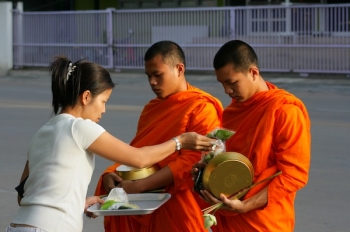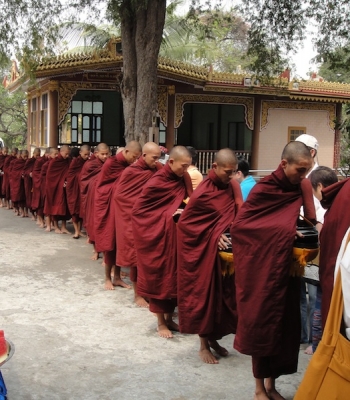--
While going through the recorded Buddhist Canon, one can find several instances of the Lord Buddha himself going for alms-round in the mornings, together with his sangha disciples following his footsteps. It was a tradition that might have been influenced by the asceticism of the Buddha’s society in those ancient times. However, regardless of the origins, what is noteworthy for our notice today is the significance of the established tradition of “Pindapata” (alms-round) that continues throughout time until today in the Buddhist sangha – the same practice that the Buddha and his prominent disciples attended to in the beginning of Buddhist history. It is therefore regarded as sacred.
The significance of alms-rounds serves to remind all of the marks of simple living, satisfaction or contentment, inter-dependency, and a humble recognition that the disciples of the Buddha throughout centuries have followed this tradition since the Buddha’s time. It is is a common custom of Buddhist monks in different countries to go for alms-round, and the Theravada Buddhist sangha in Thailand has in fact, been quite dedicated to preserve this sacred old tradition of Pindapata.
On the streets of Thailand, one can witness walking monks begging for alms every morning. They do not take a break from their daily source of survival and even during wet days, the drops of rainfall do not disturb them from their practice. These disciples of the Buddha are not obstructed from following their daily duty as they depart early in the morning dressed, taking up the bowl (pubbanhasamayam pattacivaram adaya) and the bag for their practice.
The Buddhist people throughout the country are well aware of their lay duty to the monk community. They exhibit immense appreciation towards the dutiful disciples of the Buddha. Early in the mornings, they too arrive on the streets in order to serve the monks who wander for alms. Some make preparations earlier to await the monks’ arrival as the dawn appears and provide them with an assortment of foods and drinks, and sometimes money, for various needs.
Groups of vendors and suppliers arrive even earlier than the lay devotees on the early-morning streets. They set up small and medium-sized stalls at many places and corners along the way in order to sell items such as rice, curry packets, water, and sweets for the devotees to provide and offer to the monks. The sellers arrange goods on a plate ready to be served in a convenient and easy manner so that the devotees can be ready to make offerings to the passing monks during these early alms-rounds.
Some other lay devotees prepare their offerings at home and carry outside to offer the monks and the contents of the offering are not limited to only rice, curry and water, but may additionally include items to meet three among the four requisites of a monk’s life (adequate food, clothing, medicines, and a place to live). While they cannot offer a place to live (as normally monks live in their own communities), the lay devotees can provide the other items needed for the simple life of a monk.
This is a pleasant event to behold. The recipient monk blesses the devotee with the bliss of long-life, beauty, happiness and strength, showing a simple and modest way of gratitude for the donations received.
This custom symbolizes the strong connection between monks and the lay community. The devotees, together with the aid of shop-keepers, are helping the monks with food and supplies. The great author, Thich Nhat Hanh, writes of the view that the whole environment and nature and many other beings, are all linked. In this one act of offering alms to the monks, similarly the gratitude and the blessings are automatically going to be shared with all those who are are linked in the dedicated community of support.
”Without a cloud, we cannot have paper... if we look into this sheet of paper even more deeply, we can see the sunshine in it. If the sunshine is not there, the forest cannot grow…if we continue to look we can see the logger who cut the tree and brought it to be transformed into paper. And we see the wheat. We know the logger cannot stay without his daily bread. ..logger’s father and mother...”
Thich Nhat Hanh: The Heart of Understanding
For this interactive sacred old tradition, there is no need to dig deeper into more doctrinal matters. The simple outcome of an old practice is still prevalent in the modern society. Even though materially the world advances, these remnants of traditions and practices established by spiritual leaders in history are just as valuable today. With great devotion I sincerely hope that this tradition of the Buddha can find greater practice and followers. May the Buddha’s tradition flourish more and more!
* The tradition of going for alms-round is older than 2500 years. It was a custom of ancient sages and hermits of India, who barely possessed any material at all and lived on others compassion, to go for begging for food. The Buddha was one of those who fell into one (the Samana) of the two main traditions that the religious teachers were grouped into (i.e. Samana & Brahmana). On the other hand the Brahmins didn’t beg.
















